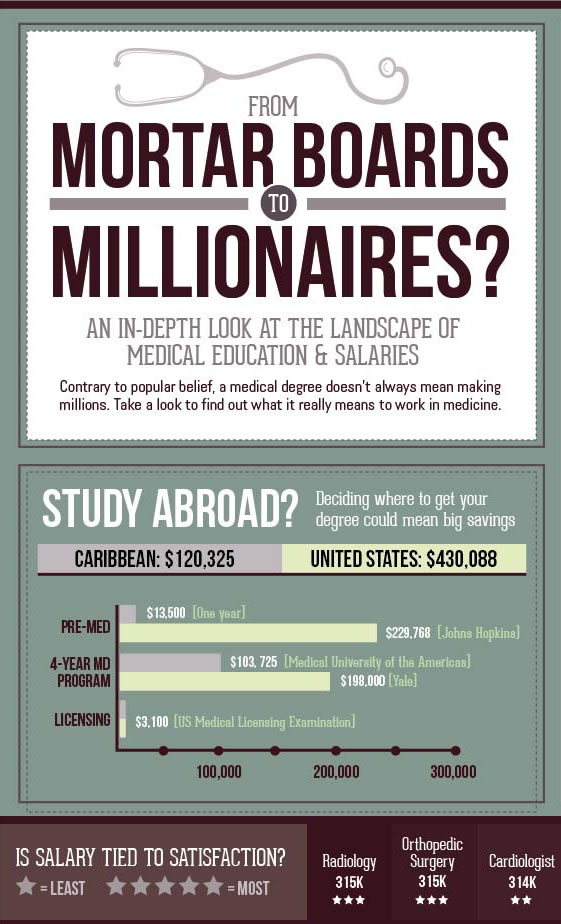Entries in Physician Salaries (2)
Physician Salaries Around The World
 Here's what the U.S. Bureau of Labor Services (BLS) report as the average salary of a physician in the US.
Here's what the U.S. Bureau of Labor Services (BLS) report as the average salary of a physician in the US.
In 2008, physicians practicing primary care had total median annual compensation of $186,044, and physicians practicing in medical specialties earned total median annual compensation of $339,738."
Let's look at a few specific specialties, in ascending order:
- General Pediatricians $161,410
- Psychiatrists $163,660
- Family and General Practitioners $168,550
- General Internists $183,990
- Obstetricians and Gynecologists $204,470
- Anesthesiologists $211,750
- Surgeons $219,770
- Physicians and Surgeons, All Other $173,860.
What do doctors in other countries make? Times Article

Source: Congressional Research Service analysis; see notes in table below
In response to Uwe Reinhardt’s recent post on “rationing” doctors’ salaries, a number of readers wrote in asking about physician compensation in other countries.
Doing a direct comparison of remuneration across different countries is tricky because the same salary may allow for different standards of living in different places.
But here are two possible ways to think about these comparisons, taken from a 2007 Congressional Research Service report entitled “U.S. Health Care Spending: Comparison with Other OECD Countries.”
One way to compare cross-country data is to adjust the salaries for purchasing-power parity — that is, adjusting the numbers so that $1,000 of salary buys the same amount of goods and services in every country, providing a general sense of a physician’s standard of living in each nation.
These numbers are in the second, fourth and sixth columns of the chart below.
They show that American general practitioners and nurses earn more than their counterparts in other developed countries, and American specialists (insert plastic surgeons & dermatologists) are close to the top of the pack.
Source: Congressional Research Service (CRS) analysis of Remuneration of Health Professions, OECD Health Data 2006 (October 2006), available at [http://www.ecosante. f /OCDEENG/70.html]. Sorted by specialists’ compensation. Amounts are adjusted using U.S. dollar purchasing power parities. Amounts from previous years are trended up to 2004 dollars using the annualized Bureau of Labor Statistics Employment Cost Index for wages and salaries of health services workers in private industry. It is not known whether wage growth in health professions in other countries was similar to that in the United States. Amounts are from previous years for 10 countries: data for Australia, Canada, Denmark (for specialists and nurses), Finland (for nurses), and the Netherlands are from 2003; data for Belgium (for specialists), Denmark (for general practitioners), New Zealand (for nurses), and Sweden are from 2002; data for Switzerland and the United States (for specialists and general practitioners) are from 2001; and data for Belgium (for general practitioners) and the United States (for nurses) are from 2000. Ratios of salaries to GDP per capita reflect the year the data was collected and are not adjusted for inflation. For countries that have both self-employed and salaried professionals in a given field, the amount presented here is the higher of the two salaries. Four countries have both salaried and self-employed specialists: the Czech Republic (where compensation is $29,484 for salaried and $34,852 for self-employed specialists), Greece ($67,119 and $64,782), the Netherlands ($130,911 and $252,727), and the United States ($170,300 and $229,500). One country has both salaried and self-employed general practitioners: in the United States, salaried general practitioners earn $134,600, compared with $154,200 if self-employed. All nurses are salaried among this data.
Another way is look at how a doctor’s salary compares to the average national income in that doctor’s country — that is, gross domestic product per capita. These numbers are in the third column, fifth and seventh columns of the chart.
As a country’s wealth rises, so should doctors’ pay. But even accounting for this trend, the United States pays doctors more than its wealth would predict:
Source: Congressional Research Service (CRS) analysis of Remuneration of Health Professions, OECD Health Data 2006 (October 2006), available at [http://www.ecosante.fr/OCDEENG/70.html].
According to this model, the 2007 report says, “The U.S. position above the trendline indicates that specialists are paid approximately $50,000 more than would be predicted by the high U.S. GDP. General practitioners are paid roughly $30,000 more than the U.S. GDP would predict, and nurses are paid $8,000 more.”
But it’s important to keep in mind, the report notes, that health care professionals in other O.E.C.D. countries pay much less (if anything) for their medical educations than do their American counterparts. In other words, doctors and nurses in the rest of the industrialized world start their medical careers with much less student loan debt compared to medical graduates in the United States.
I would also hazzard a guess that malpractice insurance for physicians in the US is multiples of what physicians in other countries need to shoulder.
If anyone has more current stats for physician income in the US I'd love it if you'd leave a link in the comments of this post.





 Post a Comment
Post a Comment


